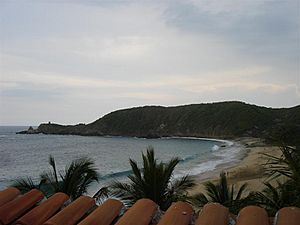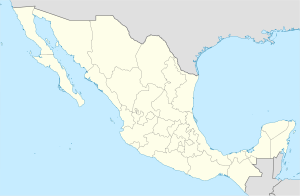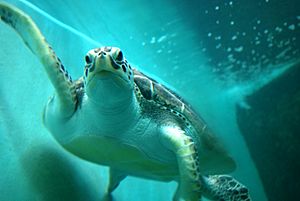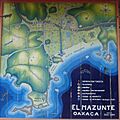Mazunte facts for kids
Quick facts for kids
Mazunte
|
|
|---|---|
|
Town
|
|

Mazunte and Punta Cometa
|
|
| Country | |
| State | Oaxaca |
| Municipality | Santa María Tonameca |
| Elevation | 30 m (100 ft) |
| Population
(2020)
|
|
| • Total | 651 |
| Time zone | UTC-6 (CST) |
| Area code(s) | 958 |
Mazunte is a small beach town found on the Pacific coast of Oaxaca, Mexico. It is about 22 kilometers (14 miles) southwest of San Pedro Pochutla. Mazunte is also close to San Agustinillo and Puerto Ángel.
The name "Mazunte" has two possible meanings. Some say it comes from a Nahuatl phrase, "maxotetia," which means "please deposit eggs here." This makes sense because many sea turtles come here to lay eggs. However, older residents say the name comes from "mizontle," a type of crab that used to be very common in the area.
Mazunte is famous for its sea turtles. For a long time, the town was a center for sea turtle hunting. But in 1990, Mexico banned hunting turtles and collecting their eggs. This ban helped save the turtles. To help the people of Mazunte, the town changed its focus to ecotourism. Now, visitors come to learn about turtles and enjoy nature.
Today, the main attractions are the Mexican National Turtle Center and a natural cosmetics company called Cosméticos Naturales de Mazunte. In 2012, Hurricane Carlotta caused a lot of damage to the town.
Contents
History of Mazunte
For many years, Mazunte was a quiet and isolated place. Only a few families lived there, making a living by fishing and farming. In the mid-20th century, people started hunting sea turtles. By the 1970s, Mazunte became the main place for sea turtle hunting in Mexico. A special building was even built to process the turtles.
Many turtles came to Mazunte to lay their eggs. But because of the hunting, the number of turtles began to drop. People became worried about the turtles disappearing. In 1990, the Mexican government made a rule that completely banned hunting sea turtles and collecting their eggs.
This ban was great for the turtles, but it meant that many families in Mazunte lost their main way to earn money. So, the government and other groups stepped in to help. They wanted to create new ways for people to make a living, focusing on protecting the turtles.
One big step was creating the Mexican National Turtle Center (Centro Mexicano de la Tortuga). This center helps protect turtles and teaches people about them. It also helps bring tourists to Mazunte. Another important project was Cosméticos Naturales de Mazunte, a company that makes natural beauty products using local ingredients. This company started in 1996 with help from The Body Shop.
The community decided to become a "Peasant Ecological Economic Reserve." This means they are dedicated to protecting turtles and their environment. Because of these efforts, the number of turtle nests has grown a lot.
In 1997, Mazunte was hit by strong storms, Hurricane Pauline and Hurricane Rick. These storms caused a lot of damage. To help the town recover and bring back visitors, new events were started. These include the Spring Equinox Festival, the International Dance Festival, and the Jazz Encounter. These events are now some of the biggest in Oaxaca.
Since the ban on turtle hunting, life in Mazunte has improved. More homes now have running water and electricity. There are also more schools and health centers.
Life in the Community
Mazunte is a small village located between a long beach and the Sierra Madre del Sur mountains. The main street, Avenida Paseo del Mazunte, runs parallel to the beach. It connects Mazunte to other nearby villages. The area has many trees that lose their leaves in the dry season. You can also find different types of cacti and mangroves here.
Mazunte is still a quiet, rural village. The buildings in Mazunte are special because they are made using natural materials. The town has rules to make sure new buildings fit in with the natural surroundings. This helps keep Mazunte from becoming too crowded or overdeveloped.
Guido Rocco, often called "the Italian" or "the architect," is famous for building many eco-friendly homes and buildings here. He calls his style "bio-architecture." These buildings use materials like palm fronds, adobe, bamboo, shells, stones, and wood. They are designed to blend in with the beautiful landscape.
Many Italians have moved to Mazunte and other towns along this coast. You can see their influence in the Italian restaurants, some of which cook pizza in wood-fired ovens!
Cosméticos Naturales de Mazunte
Cosméticos Naturales de Mazunte is a local business that makes high-quality, eco-friendly makeup and other products. It started with support from the British company The Body Shop and the Mexican government. Other groups and universities also helped with design and product knowledge.
The cooperative makes shampoo, conditioner, bath gels, soap, and more. It's also a popular place for tourists to visit. Buses bring people to see how the products are made and to shop. The cooperative's slogan is "el milagro de Mazunte," which means "the miracle of Mazunte."
Festivals and Transportation
The Mazunte Jazz Festival started in 2005 and happens every year. It is one of the biggest jazz festivals in Oaxaca state. The annual Fiesta de Mazunte is held in January. It includes fun events like parades, a Miss Bikini contest, and a fishing contest.
Public transportation in Mazunte uses pickup trucks that have been changed to carry people and goods. These "camionetas" connect Mazunte with nearby towns like La Ventanilla to the west, and San Agustinillo, Zipolite, Puerto Angel, and Pochutla to the east.
Beautiful Beaches
Mazunte has a beach that is about 1 kilometer (0.6 miles) long. At the far west end, there is a quiet, hidden cove. From this beach, you can take boat tours to other nearby beaches like Zipolite and Puerto Ángel.
Depending on the time of year, you might see amazing sea animals like whales, dolphins, sea turtles, and manta rays. You can also rent boats for sport fishing. The main beach and the cove both have small hotels and restaurants. Lifeguards are on duty during the busy tourist seasons to keep everyone safe.
There are also two other peaceful, undeveloped beaches nearby: Playa Mermejita on Punta Cometa and Playa Escobilla to the west.
Sea Turtle Nesting and Conservation
Almost all types of marine turtles come to the Mazunte area to lay their eggs. Some land and freshwater turtles also visit. Mazunte is especially famous for its sea turtles. Thousands of olive ridley sea turtles come together to lay their eggs in nearby Escobilla Bay. This nesting season usually starts in May and lasts for several months.
Even though these turtles are endangered, they arrive in huge numbers on the beach a few nights after a full moon. These events are called arribadas. Other types of turtles that lay eggs here include the Hawksbill turtle, the "prieta" (a kind of green turtle), and some leatherback turtles. In 1997, nearly 900,000 sea turtles arrived at La Escobilla beach alone!
Volunteers from the Mexican National Turtle Center watch over the nesting areas around Mazunte. When female turtles come onto the beaches at night, they are measured and tagged. Their eggs are carefully collected and taken to the center to hatch safely. Later, the baby turtles are released back onto the same beaches. Sometimes, visitors can even help release the tiny hatchlings!
Mexican National Turtle Center
The idea of using sea turtles to attract tourists started in the 1970s. This was when sea turtle hunting was at its peak in Mazunte. A small center was created in 1985 to promote this idea.
The modern Centro Mexicano de la Tortuga (Mexican National Turtle Center) was officially opened by the government in 1991. This happened after the complete ban on sea turtle hunting in Mexico. The center is both an aquarium and a research facility dedicated to turtles. It focuses especially on sea turtles.
The center covers four hectares (about 10 acres) and is located right next to the beach in Mazunte. It's even near where the old sea turtle processing building used to be. The center has examples of all the marine turtles found in Mexico. It also has six types of freshwater turtles and two types of land turtles from the country.
You can see many different turtle species in tanks and other special habitats. The buildings at the center are designed to look like a mix of traditional and modern styles. Outside, there are tanks with turtles of different ages. There are also natural and artificial places for turtle eggs to hatch.
The center also has a multi-purpose room, a gift shop, and a cactus garden. Its main goals are to find ways to manage, increase, and protect Mexico's turtle species. It also aims to teach people about turtles and encourage eco-tourism based on them. About 60,000 people visit this amazing center every year.
Punta Cometa
The western end of Mazunte beach is next to Punta Cometa. This is a small piece of land or a mountain that sticks out into the ocean. Punta Cometa is also called Cerro Sagrado, which means "Sacred Hill." It is the southernmost point in the state of Oaxaca.
Punta Cometa is an important resting place for birds that migrate (travel long distances). It's also a spot where you might see marine mammals like whales. On the west side of Punta Cometa, there is a small, untouched beach called Mermejita.
Long ago, before the Spanish arrived, this area was a military outpost for the Aztecs. They built a small wall around Punta Cometa. You can still see parts of it today, and locals call it the "corral de piedra" or "stone corral." During the time of Spanish rule, this spot was used by both Spanish soldiers and pirates. Its high position gave them a great view of the ocean. There are also old stories about Aztec or pirate treasure hidden at Punta Cometa!
Images for kids
See also
 In Spanish: Mazunte para niños
In Spanish: Mazunte para niños








